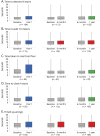Assessment of disease progression in dysferlinopathy: A 1-year cohort study
- PMID: 30626655
- PMCID: PMC6369904
- DOI: 10.1212/WNL.0000000000006858
Assessment of disease progression in dysferlinopathy: A 1-year cohort study
Abstract
Objective: To assess the ability of functional measures to detect disease progression in dysferlinopathy over 6 months and 1 year.
Methods: One hundred ninety-three patients with dysferlinopathy were recruited to the Jain Foundation's International Clinical Outcome Study for Dysferlinopathy. Baseline, 6-month, and 1-year assessments included adapted North Star Ambulatory Assessment (a-NSAA), Motor Function Measure (MFM-20), timed function tests, 6-minute walk test (6MWT), Brooke scale, Jebsen test, manual muscle testing, and hand-held dynamometry. Patients also completed the ACTIVLIM questionnaire. Change in each measure over 6 months and 1 year was calculated and compared between disease severity (ambulant [mild, moderate, or severe based on a-NSAA score] or nonambulant [unable to complete a 10-meter walk]) and clinical diagnosis.
Results: The functional a-NSAA test was the most sensitive to deterioration for ambulant patients overall. The a-NSAA score was the most sensitive test in the mild and moderate groups, while the 6MWT was most sensitive in the severe group. The 10-meter walk test was the only test showing significant change across all ambulant severity groups. In nonambulant patients, the MFM domain 3, wrist flexion strength, and pinch grip were most sensitive. Progression rates did not differ by clinical diagnosis. Power calculations determined that 46 moderately affected patients are required to determine clinical effectiveness for a hypothetical 1-year clinical trial based on the a-NSAA as a clinical endpoint.
Conclusion: Certain functional outcome measures can detect changes over 6 months and 1 year in dysferlinopathy and potentially be useful in monitoring progression in clinical trials.
Clinicaltrialsgov identifier: NCT01676077.
Copyright © 2019 The Author(s). Published by Wolters Kluwer Health, Inc. on behalf of the American Academy of Neurology.
Figures


References
-
- Bushby K, Straub V. One gene, one or many diseases? Simplifying dysferlinopathy. Neurology 2010;75:298–299. - PubMed
-
- Nguyen K, Bassez G, Bernard R, et al. . Dysferlin mutations in LGMD2B, Miyoshi myopathy, and atypical dysferlinopathies. Hum Mutat 2005;26:165. - PubMed
-
- Krahn M, Beroud C, Labelle V, et al. . Analysis of the DYSF mutational spectrum in a large cohort of patients. Hum Mutat 2009;30:E345–E375. - PubMed
Associated data
LinkOut - more resources
Full Text Sources
Other Literature Sources
Medical
